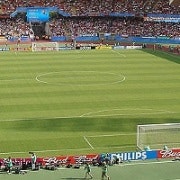How does the World Cup affect markets?
The 2014 World Cup has kicked off with much fanfare as the host nation Brazil took out the first match of the tournament with a 3-1 win over Croatia.
It’s a marketer’s dream; 30 days of high intensity advertising -- FIFA itself estimates the 2014 tournament will break the record for the most watched event in history and will surpass the 2010 tournament viewers (approx. 3.2 billion).
With so many eyeballs glued to the TV screen, rather than markets, what happens to trading? Does the local market see a return on the investment made to host the event? Does the currency see upside as football fans pile into the country? And what happens in the aftermath?
I’ll start by examining what happened to local markets before, after and during previous World Cups.
1998 - France
France became the first host nation to win the World Cup since West Germany in 1974; it was also the country’s first and only World Cup win, beating Brazil 3-0. However, trading on the CAC during this period was flat, with an increase of just 1.13 per cent.
During the event, volumes were consistently below the 30-day moving average. Interestingly, the CAC saw lower and lower volumes as the tournament dragged on, likely due to the fact that France was winning and therefore more local investors were watching the national team rather than their positions. However, after the event the CAC added 8.5 per cent.
2002 – Japan and South Korea
Brazil took the Cup home in 2002, beating Germany 2-0 in the final. It’s worth noting this was the first World Cup to be held in Asia.
The Nikkei actually experienced quite a negative effect from the Cup. The index lost over 9.9 per cent during the tournament itself and fell a further 14.3 per cent from the end of the event until June 30 in 2003.
Tourism was actually weaker-than-expected according to estimates, as Asian tourists actually held off traveling to Japan during the event. The currency saw strength over the hosting month, adding five yen (up 3.6 per cent) to ¥119; a level the BoJ and the Abe government would love to see again.
The constant for the Nikkei were the volumes during the Cup month, which were consistently below the 30-day moving average and didn’t return until after the June 30.
2006 - Germany
The 2006 final saw the infamous nil-all draw between France and Italy, with a 10-man France holding on, only to go down to Italy on penalties. The tournament was held from June 9 till July 9, well before anyone had heard of the term 'GFC', when PIIGS were a favourite German meat source, not countries in crisis.
The DAX benefited from the Cup from the get-go, adding 4 per cent over the month. Tourism boomed, and estimates put the number of fans in the range of half a million. The EUR saw a two cent rise over the month and continued to rise after the event. However, like France and Japan, volumes in the markets were well below the 30-day average, showing that not only were fans physically turning up, but they were also glued to the TV.
In the 12 months after the event, the DAX added 36.2 per cent.
2010 – South Africa
The 2010 World Cup saw Spain win its first final and the Netherlands remain as the figurative bridesmaid; finishing second for a third time. The event was staged from June 11 to July 11 and over that time the JSE Top 40 lost 1.1 per cent and saw volumes well below the 30-day moving average. This was mirrored by the S&P and most European markets which all saw volumes well below their respective 30-day averages and flat trade.
The ZAR saw solid support over the event as South African Tourism estimated over 309,000 tourists from around the world attended the event. The currency then fell in the following month.
What is also interesting is that the local market saw a 15.1 per cent rise in the 12 months after the event. This was despite the fact that the globe was still trying to fight off the effects of the GFC.
2014 – Brazil
So what can we expected from Brazil? Well if the first day of trade is anything to go by it could be positive, despite the very public issues facing organisers as strikes and hold ups hit the tournament.
Overnight the Ibovespa added 0.91 per cent. History suggests that the 12 months after the event should be positive for the market, but it also shows that trading volumes will likely be low during the event as investors turn into fans.
















